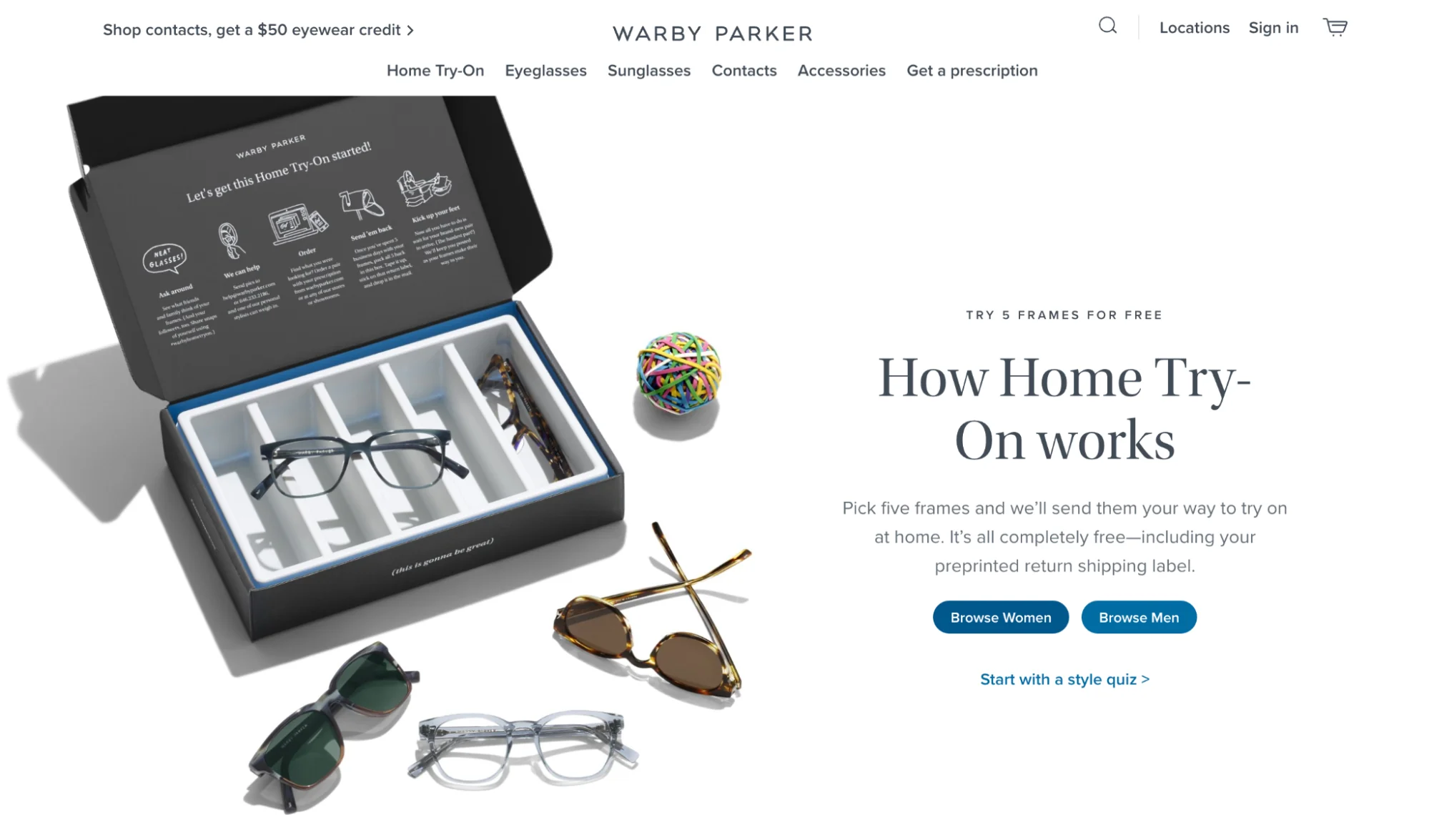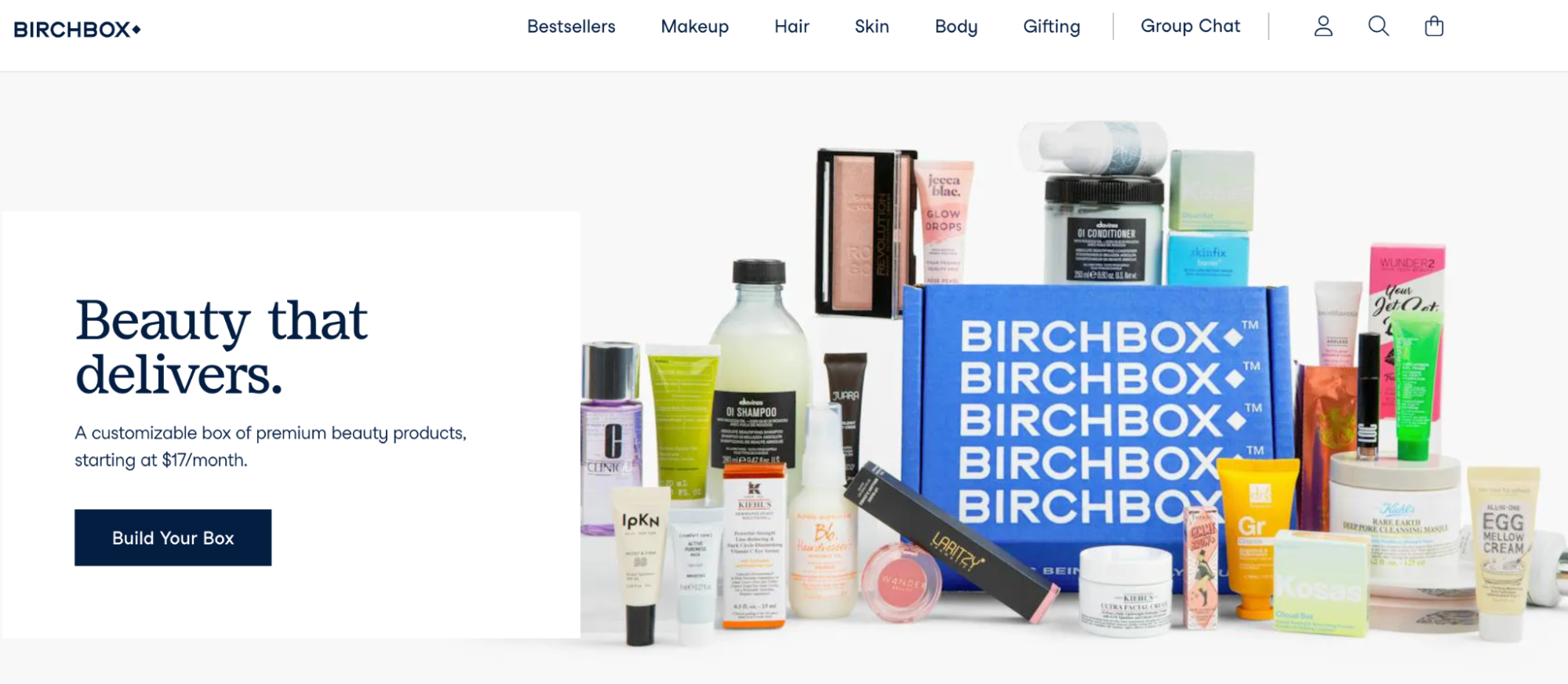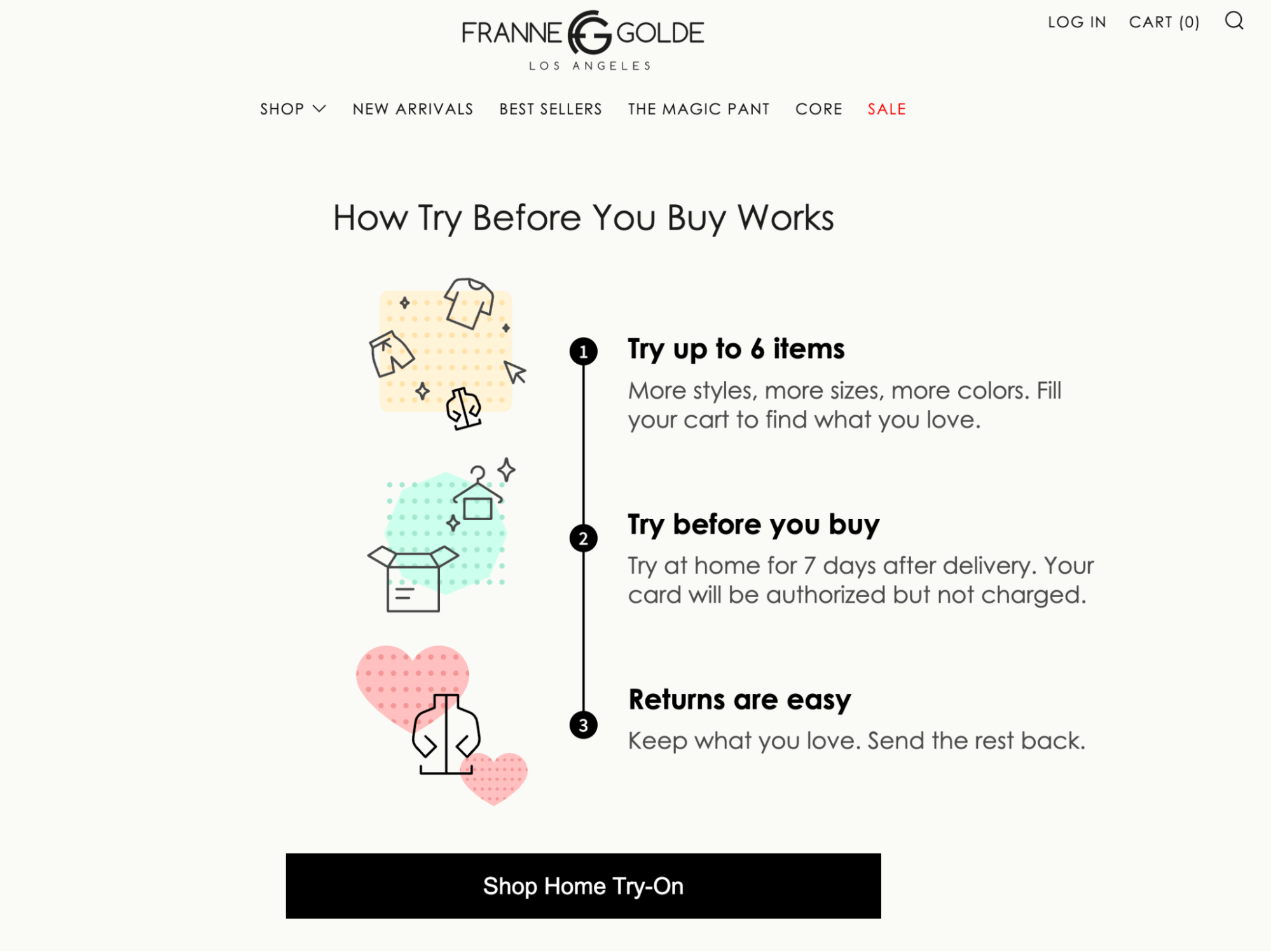Try before you buy is a sales model that lets customers try on or test products in the convenience of their home before completing payment.
It can also take place in-store, in the form of appointment shopping or showrooming, and online via virtual shopping or augmented reality (AR) apps. Depending on the structure of your try-before-you-buy program, customers can send back the items they don’t want, either for free or for a small fee.
While more brands are experimenting with try-before-you-buy programs, there are a few frontrunners in this space. Ahead, you’ll learn about the most popular programs and how to start your own today.
What is try before you buy?
Try before you buy lets customers see and try products before making a purchase. Similar to how shoppers try on or test merchandise in-store, this order fulfillment option usually involves sending products to the customer so they can try before buying, or scheduling an in-store appointment to do the same.
How does try before you buy work?
Try before you buy is a win-win situation for both the brand and the customer. Here's how a try before you buy transaction typically works:
- A shopper selects the items they’re interested in purchasing.
- The customer can try these items either at home or in-store.
- For home trials, products are delivered to the customer’s doorstep.
- The customer then uses and tests the products for a specified period, usually ranging from a few days to a couple of weeks.
- If the customer decides they want to keep the item, they pay for it. If not, they return it to the retailer. Returns can happen in person or via shipping, often with prepaid return labels provided.
Examples of try before you buy programs
1. Amazon
Prime Try Before You Buy (formerly Amazon Prime Wardrobe) is the try-before-you-buy service that allows Prime subscribers to try on clothes and accessories at home before deciding whether to purchase them.

The way Prime Try Before You Buy works is pretty simple:
- A shopper browses eligible items on Amazon. Eligible items will be marked with the Prime Try Before You Buy logo.
- The customer will toggle on “Prime Try Before You Buy” before checkout and then click Buy Now & Try Free.
- Next, they try on the items at home and keep what they love. They’ll have up to seven days to try on the items in the comfort of their own home.
- Customers will only be charged for the items they decide to keep, and they’ll receive a discount on their purchase if they keep three or more items. If they decide to return any unwanted items, they’ll have to place them in the return bag (prepaid return label included) and drop it off at a UPS location.
Prime Try Before You Buy also has several features for consumers that set it apart from the competition:
- Prime membership: The program is available only to Amazon Prime members, which means shoppers have access to other Prime perks, such as free two-day shipping, streaming of movies and TV shows, and more.
- Prime Personal Shopper: With Prime, customers can hire a personal shopper for $4.99 per styling.
- Wide selection: As mentioned earlier, Amazon has a vast selection of clothing and accessories available, from brands like Levi’s and Adidas, making it easier to find what they’re looking for.
2. Wayfair
Home improvement retailer Wayfair has a 3D room planner feature that lets shoppers use AR to visualize a range of decorations, furniture, and other products in their home.

Shoppers can start by creating a floor plan that matches the dimensions of the room they’re decorating, including windows, doors, radiators, and more.
While it’s still important to compare the dimensions of virtual products against a real room, this try-before-you-buy option lets customers see how Wayfair’s furniture and decorative accessories fit into their space in real time, before completing their purchase.
3. Warby Parker
Popular DTC eyewear brand Warby Parker offers a Home Try-On program to let customers try five different frames—either regular or sunglasses—for free over a period of five business days.

Once the try-before-you-buy period is over, customers must return the items they don’t want (using a prepaid return shipping label), and can purchase the item(s) they like.
4. Gemist
Gemist, a jewelry brand that sells customizable, made-to-order rings and earrings, offers a Try-On Experience through its online store to let customers choose three ring styles to try for up to 14 days.

When the customer orders its curated box of try-on rings, they’re charged a $45 deposit that gets refunded in full once the Try-On Box has been returned. If the customer chooses to keep some or all of the rings, they’re charged the full retail price for each.
5. Stitch Fix
Stitch Fix offers customers a personalized shopping experience using a combination of data science and curated collections picked out by human stylists.

For a $20 styling fee, customers receive five items and can decide whether to keep or return them. If a customer keeps all the items in a shipment, they receive a 25% discount. Customers can subscribe to receive shipments monthly, quarterly, or at a frequency of their choosing.
Stitch Fix uses a unique algorithm, along with hand-picked recommendations from a real stylist, to predict a customer’s style preferences.
The more feedback a customer offers on which types of clothing items they prefer, based on online images where they can select a thumbs up or a thumbs down, the more artificial intelligence learns about their style. Customers can also select a price range for how much they are willing to spend on each item.
This highly customized try-before-you-buy model is what has helped Stitch Fix become so successful. The hand-picked offerings are resonating with an increasing number of customers.
6. Casper
Digitally native mattress brand Casper lets customers try mattresses for 100 nights before deciding to buy.

There’s also a minimum 30-night trial period to give your body time to adjust to a new mattress. If customers decide after 30 days that the mattress is not for them, Casper picks up the unwanted mattress and provides a full refund, as long as it’s not damaged.
The brand also offers a 30-night trial for other “snooze supplies.” This includes pillows, bedding, glow lights, dog beds, and furniture.
7. Birchbox
With a $17-per-month subscription, Birchbox customers receive beauty product samples chosen specifically to match their profile, including skin or hair type.

They can try the products and purchase the full-size version on the Birchbox shop, which offers 500 brands, from MAC and Kiehl’s to up-and-comers like Sunday Riley and OUAI.
Founded in 2010, the company has more than one million subscribers and 2.5 million active customers. Some 35% of revenue comes from sales of full-size samples online, and about 50% of subscription customers shop for full-size products on Birchbox.com, according to the company’s fact sheet.
8. Franne Golde
Franne Golde has a generous try before you buy program for online shoppers. You can order up to 6 items and try them at home for 7 days after delivery. Franne Golde authorizes but does not charge the shopper's card until after they return unwanted items.

9. Mara Hoffman
Mara Hoffman is a fashion brand with its own home try-on program as well. Shoppers can browse the try before you buy clothing collection and order up to eight items to be shipped to their home for fittings.

Customers have up to seven days to return any unwanted items, at which point they’ll be charged for anything they keep.
💡Want to start your own program? Use a try before you buy app from the Shopify App Store.
Benefits of try before you buy
Differentiate your brand and products
Offering a try before you buy can give you a competitive advantage over retailers that don’t.
For fine jewelry brand Gemist, try before you buy helped differentiate its brand by letting consumers try on fashion replicas of their ring designs, resulting in a fine jewelry purchase (often an engagement purchase) of that design.
“We always learn and listen to our consumers, and when we launched this experience. many of them were also interested in purchasing the try-on replica—what we call a ‘stand-in ring’—for things like travel, the beach, and working out,” says Menaka Sampath, Marketing Director at Gemist.
“Now we have an additional revenue stream from this feature that we didn’t originally anticipate. That’s the beauty of trying something new: you never know what other benefits will come from it.”
Reach new markets
Letting customers try products before they buy can help alleviate any second thoughts they’re having about purchasing from a new business or ordering products they’re not familiar with.
Try-before-you-buy is a great way to attract consumers who are generally apprehensive about online shopping. The fact that they don’t need to pay unless they’re satisfied with their order can make people feel more comfortable and confident about buying your products online.
Build trust, customer satisfaction, and loyalty
Not only does try before you buy help attract new customers, but it also gives your existing customer base more flexibility and convenience to try new products.
Improving the flexibility of your shipping and return policies can boost trust in your business, encourage customers to continue buying from you, and have those customers likely tell their friends and family about the benefits of your try-before-you-buy policy.
Boost brand awareness
Try before you buy is a great way to offer a smooth and convenient shopping experience that encourages customers to return, as well as spread the word about your business. It’s also a great way to get more products into the hands of customers.
Whether they buy immediately or not, offering an easy way to try products without commitment can help move first-time customers through the buying journey.
Increase sales
Consumers today are inundated with choices, making shopping online more of a chore than retail therapy. But try before you buy makes it easier for customers to compare options in person, attracting an audience of people who prefer to touch and try products before they pay—and they can do it from the convenience of their home.
“The best thing about home Try-On, especially for a luxury product like fine jewelry, is that it takes the risk out of the purchase,” says Sampath.
“Our Try-On customer usually has an AOV three times higher than customers who go directly to customizing and buying online without participating in our Try-On Experience. For us, it has been a fantastic way to innovate within the fine jewelry space and bring the romance of brick-and-mortar to the consumer. We have seen great growth across the board with this unique experience,” Sampath adds.
Reduce return rates
It may sound counterintuitive, but letting shoppers try products before they buy can help reduce your order return rates. Why? If customers get to touch and try products before they actually pay, the likelihood of returns due to fit issues or the item being different than what they expected will decrease.
Challenges of try before you buy
Expensive items go missing
Try before you buy is perfect for high-cost items, but it’s also risky. The higher the product value, the more risk. It’s not unheard of for fraudsters to get a trial product and keep it without the intention of paying.
But there are solutions. For example, you can store a card on file that a customer agrees you can charge if they don't return it within a specific time frame.
Products are too delicate
Every time you touch a product, you run the risk of breaking or damaging it. Over time, some products may become weaker and less able to withstand all the moving around. Then add to that the wear and tear of the trial period.
Some products may not even last through the trial period. For example, can glassware survive the process of shipping out, trying, and shipping back? Or maybe a customer misuses your product during their trial and breaks it as a result.
You can invest in protective packaging to make sure items are safe during transit. You might also limit your try before you buy program to certain products, focusing on those that are more durable.
Return shipping becomes expensive
Shipping costs are a challenging reality in business. Many try before you buy programs include free shipping both ways, and that can be a decent amount considering return shipments often mean you didn’t make the sale.
The solution? Bake return shipping costs into the product price or change shipping courier to a cheaper alternative.
Logistics is hard to manage
Anytime you add flexible and non-linear purchase paths to your business, logistics gets a bit more complicated, especially when dealing with the shipment of trial products to and from customers. Ensuring timely delivery, tracking return shipments, and managing inventory levels can become complex tasks, especially as you get more and more trial orders.
One way to offset this stress is through partnering with a third-party logistics provider (3PL). A 3PL can handle storage, fulfillment, and shipping processes, allowing you to focus on other core activities.
Inventory management
Effective inventory management is both essential and convoluted when it comes to a try-before-you-buy program. As trial products are sent out to customers and returned, you need accurate visibility into inventory levels to prevent stockouts or overstock situations. Without proper inventory management, you risk disappointing customers with out-of-stock items or tying up capital in excess inventory.
Invest in inventory management software that integrates with all your business tools, especially your point-of-sale and ecommerce platform. There are tons of Shopify apps, for example, that can help you stay on top of inventory with a try before you buy program.
Is a try before you buy program right for your retail business?
Offering try-before-you-buy options can help differentiate your brand from competitors. It can also help you reach a growing audience of consumers looking for flexible and free shipping options. But before you decide if it’s right for your business, it’s important to make sure it’s logistically and financially possible.
Read more
- What Are Virtual Fitting Rooms and How Do They Work? (2024)
- Going Mobile: 6 Reasons to Invest in Your Own Retail Store App
- Lightspeed vs Shopify POS: The Best of All Lightspeed Alternatives
- Shipping Success: Put Your Customer In Control of Delivery Options
- How Retail Store Owners Can Optimize Their Mobile Presence
- 5 Strategies to Future Proof Your Brick-and-Mortar Store





